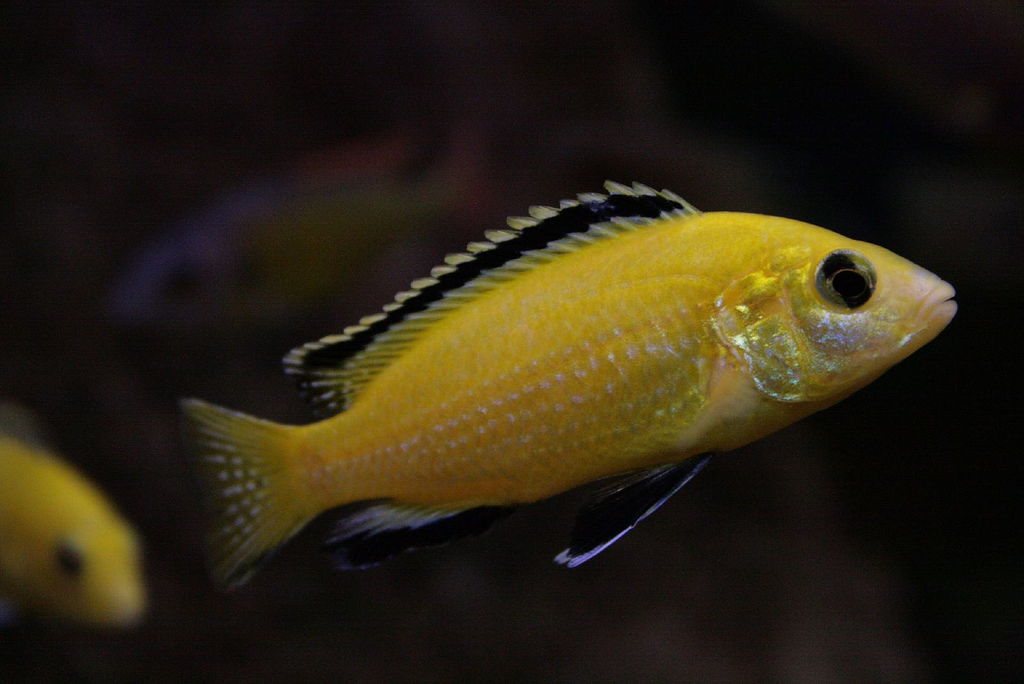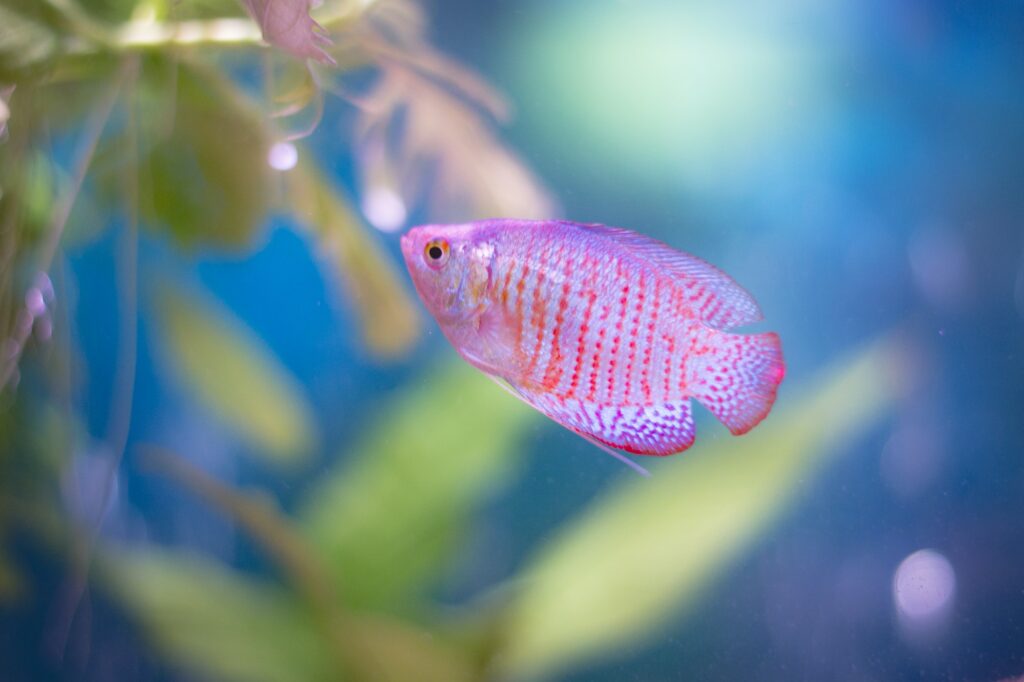Deep within the waters of Lake Malawi, a stunning freshwater species has captured the hearts of aquarium enthusiasts worldwide. With its striking colors and dynamic personality, the Red Zebra Cichlid is a popular choice for those seeking to add a touch of vibrancy to their aquatic world.
Table of Contents
The Red Zebra Cichlid belongs to the family Cichlidae and is scientifically known as Maylandia estherae or Metriaclima estherae. Its genus, Maylandia, is a subject of debate among ichthyological taxonomists, with some using Metriaclima instead. This species is a haplochromine cichlid, a group known for their diverse colors and complex behaviors.
What makes the Red Zebra Cichlid particularly fascinating is its unique blend of beauty and territorial behavior. Males display a bright red or orange color, while females are predominantly orange, with the intensity of their coloration varying based on diet, health, and mood. Their territorial nature, especially during breeding, presents a captivating spectacle for aquarium hobbyists.
In the wild, Red Zebra Cichlids inhabit the rocky, sandy-bottomed environments of Lake Malawi. They are omnivores, requiring a diet that includes a mix of commercial cichlid pellets, spirulina, and occasional treats like brine shrimp or bloodworms. In captivity, replicating their natural habitat with a rocky, hardscaped aquarium and providing a balanced diet is crucial for their well-being.
Red Zebra Cichlids are known for their aggressive and territorial behavior, especially during breeding. Males are particularly dominant and will fiercely defend their territories from other males. In a community tank, it’s essential to provide plenty of hiding spots and to choose tankmates carefully to avoid conflicts.
Fun Facts:
- Red Zebra Cichlids are mouthbrooders, with females carrying fertilized eggs in their mouths until they hatch.
- They are polymorphic, meaning they can be found in different colors and morphs, including the popular “marmalade cat” variant.
- In the aquarium trade, early exporters often selected the red females and used O-morph males to create a strain of orange-red males, making it the most commonly found variant from breeders and fish keepers.
First described by Konings in 1995 as Pseudotropheus estherae, the Red Zebra Cichlid has since been reclassified into the genus Maylandia. The species name estherae honors Esther Grant, the wife of the cichlid exporter Stuart M. Grant.

Red Zebra Cichlid Key Information
The Red Zebra Cichlid is renowned for its striking coloration, with males typically displaying a bright red or orange hue, while females are predominantly orange. The intensity of their color can vary based on diet, health, and mood. Interestingly, juveniles often exhibit a pink or light peach color, which deepens as they mature.
Red Zebra Cichlid Information Table
| Family | Cichlidae |
| Origin | Lake Malawi, Africa |
| Price | $6 – $15 |
| Common Names | Red Zebra Cichlid, Esther Grant’s Zebra, Red Zebra Mbuna, Red Mbuna Cichlid |
| Variants | Several color morphs, including blue |
| Ideal Tank Size | Minimum 50 gallons |
| Water Parameters | Temperature: 74-82°F (23-28°C), pH: 7.5-8.6, Hardness: Moderate to high |
| Lifespan | Approximately 10 years |
| Full Size | Up to 5 inches (12.7 cm) |
| Natural Environment | Rocky, sandy-bottomed shoreline habitats in Lake Malawi |
| Behavior | Aggressive and territorial, especially during breeding |
| Habitat Preference | Rocky environments with plenty of hiding spaces |
| Aquarium Decoration | Rocks, caves, sand or fine gravel substrate |
| Ideal Tank Mates | Other African cichlids of similar size and temperament |
| Fish to Avoid | South American cichlids, fin-nippers, and peaceful community fish |
| Best Foods/Diet | Omnivorous – commercial cichlid pellets, spirulina, and frozen treats |
| Disease | Susceptible to Ich, fin rot, and bloat |
| Sex-switch | No |
| Gender Differences | Males are larger, with more vibrant colors and elongated dorsal fins |
| Care Level | Moderate to advanced |
| Breeding Level | Moderate to advanced |
Ideal Tank Mates for Red Zebra Cichlid
When choosing tank mates for Red Zebra Cichlids, it’s essential to consider their compatibility, behavior, and requirements. Red Zebra Cichlids are territorial and can be aggressive, so it’s crucial to select tank mates that are peaceful, non-competitive, and can thrive in the same water conditions.
Understanding the Requirements
Red Zebra Cichlids are native to Lake Malawi, and their tank mates should be able to tolerate the same water parameters, including a pH range of 7.5-8.5 and a temperature range of 72-82°F (22-28°C). The tank should be at least 55 gallons, with plenty of hiding places, rocks, and plants to provide a comfortable environment for all inhabitants.
The Importance of Compatibility
Compatibility is key when selecting tank mates for Red Zebra Cichlids. Avoid choosing fish that are too similar in appearance or behavior, as this can lead to aggression and competition. Instead, opt for fish that are peaceful, non-competitive, and can coexist harmoniously with Red Zebra Cichlids.
Here are 10 ideal tank mates for Red Zebra Cichlids, each with its unique characteristics and requirements:
1. Yellow Lab Cichlid

The Yellow Lab Cichlid is a peaceful, non-competitive fish that is compatible with Red Zebra Cichlids. They are easy to care for and can thrive in the same water conditions.
| Common/Market Names | Price Range | Care Level | Behavior | Life Span | Max Size |
|---|---|---|---|---|---|
| Yellow Lab, Electric Yellow Cichlid | $5-$10 | Easy | Peaceful | 8-10 years | 4-5 inches |
2. Jewel Cichlid

The Jewel Cichlid is a beautiful, peaceful fish that can coexist with Red Zebra Cichlids. They require a slightly acidic pH and plenty of hiding places.
| Common/Market Names | Price Range | Care Level | Behavior | Life Span | Max Size |
|---|---|---|---|---|---|
| Jewel Cichlid, African Jewel Cichlid | $10-$20 | Moderate | Peaceful | 8-10 years | 4-6 inches |
3. Plecos

Plecos are armored catfish that are compatible with Red Zebra Cichlids. They are peaceful, non-competitive, and can thrive in the same water conditions.
| Common/Market Names | Price Range | Care Level | Behavior | Life Span | Max Size |
|---|---|---|---|---|---|
| Plecos, Armored Catfish | $10-$50 | Easy | Peaceful | 10-15 years | 6-12 inches |
4. Cuckoo Catfish
The Cuckoo Catfish is a peaceful, non-competitive fish that can coexist with Red Zebra Cichlids. They require a slightly acidic pH and plenty of hiding places.
| Common/Market Names | Price Range | Care Level | Behavior | Life Span | Max Size |
|---|---|---|---|---|---|
| Cuckoo Catfish, Synodontis Catfish | $5-$10 | Easy | Peaceful | 8-10 years | 4-6 inches |
5. Zebra Danio

The Zebra Danio is a peaceful, active fish that can thrive in the same water conditions as Red Zebra Cichlids.
| Common/Market Names | Price Range | Care Level | Behavior | Life Span | Max Size |
|---|---|---|---|---|---|
| Zebra Danio, Striped Danio | $2-$5 | Easy | Active | 5-7 years | 2-3 inches |
6. Lemon Tetra

The Lemon Tetra is a peaceful, schooling fish that can coexist with Red Zebra Cichlids. They require a slightly acidic pH and plenty of hiding places.
| Common/Market Names | Price Range | Care Level | Behavior | Life Span | Max Size |
|---|---|---|---|---|---|
| Lemon Tetra, Yellow Tetra | $5-$10 | Easy | Schooling | 5-7 years | 2-3 inches |
7. Harlequin Rasboras

The Harlequin Rasboras is a peaceful, active fish that can thrive in the same water conditions as Red Zebra Cichlids.
| Common/Market Names | Price Range | Care Level | Behavior | Life Span | Max Size |
|---|---|---|---|---|---|
| Harlequin Rasboras, Red Rasboras | $5-$10 | Easy | Active | 5-7 years | 2-3 inches |
8. Corydoras Catfish

The Corydoras Catfish is a peaceful, non-competitive fish that can coexist with Red Zebra Cichlids. They require a slightly acidic pH and plenty of hiding places.
| Common/Market Names | Price Range | Care Level | Behavior | Life Span | Max Size |
|---|---|---|---|---|---|
| Corydoras Catfish, Cory Cats | $5-$10 | Easy | Peaceful | 8-10 years | 2-4 inches |
9. Dwarf Gouramis

The Dwarf Gouramis is a peaceful, non-competitive fish that can coexist with Red Zebra Cichlids. They require a slightly acidic pH and plenty of hiding places.
| Common/Market Names | Price Range | Care Level | Behavior | Life Span | Max Size |
|---|---|---|---|---|---|
| Dwarf Gouramis, Pygmy Gouramis | $5-$10 | Easy | Peaceful | 5-7 years | 2-3 inches |
10. Otocinclus Catfish

The Otocinclus Catfish is a peaceful, non-competitive fish that can coexist with Red Zebra Cichlids. They require a slightly acidic pH and plenty of hiding places.
| Common/Market Names | Price Range | Care Level | Behavior | Life Span | Max Size |
|---|---|---|---|---|---|
| Otocinclus Catfish, Oto Cats | $5-$10 | Easy | Peaceful | 5-7 years | 2-4 inches |
These tank mates are compatible with Red Zebra Cichlids and can thrive in the same water conditions. However, it’s essential to research and understand the specific needs and requirements of each species before introducing them to the same tank.
FAQs about Red Zebra Cichlid
How Often Should I Feed My Red Zebra Cichlids?
Feed your Red Zebra Cichlids 2-3 times a day, only as much as they can consume within a few minutes. Overfeeding can lead to digestive issues and poor water quality.
Can I Keep Red Zebra Cichlids with Other Types of Fish?
Red Zebra Cichlids are best kept with other African cichlids of similar size and temperament. Avoid keeping them with peaceful community fish, as they can be aggressive and territorial.
How Do I Sex Red Zebra Cichlids?
Males are typically larger and more colorful than females, with longer dorsal fins and a more vibrant red or orange color. Females are smaller and less colorful, with a more subdued orange or yellow color.
Can I Breed Red Zebra Cichlids in a Community Tank?
It’s not recommended to breed Red Zebra Cichlids in a community tank, as the male can become aggressive and territorial during breeding. A separate breeding tank is recommended to ensure the health and safety of both the breeding pair and the other fish in the community tank.
How Long Does It Take for Red Zebra Cichlids to Reach Maturity?
Red Zebra Cichlids typically take 6-12 months to reach maturity, depending on factors such as diet, water quality, and tank conditions.
Can I Keep Red Zebra Cichlids in a Small Tank?
No, Red Zebra Cichlids require a minimum tank size of 55 gallons to thrive. Keeping them in a small tank can lead to stress, aggression, and poor health.
How Often Should I Change the Water in My Red Zebra Cichlid Tank?
Regular water changes are essential to keep your Red Zebra Cichlids healthy. Change 10-20% of the tank water weekly to maintain optimal water quality.
Can I Use Live Plants in My Red Zebra Cichlid Tank?
Yes, live plants can be used in a Red Zebra Cichlid tank, but they must be able to withstand the cichlids’ digging and territorial behavior. Hardy plants such as Anubias and Java Fern are good options.
How Do I Treat Diseases in My Red Zebra Cichlids?
Common diseases in Red Zebra Cichlids include Ich, fin rot, and bloat. Treat diseases promptly with antibiotics or other medications specifically designed for cichlids, and maintain good water quality to prevent the spread of disease.
Can I Keep Red Zebra Cichlids with Snails or Shrimp?
Red Zebra Cichlids are known to be aggressive towards snails and shrimp, so it’s not recommended to keep them together. The cichlids may see the snails or shrimp as food and attack them.